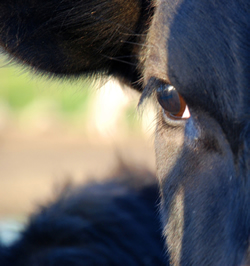A California Fairy Tale
Gather around, kids. I’m going to tell you a story about the far-out land of California.
Once upon a time, contented cows chewed cud and milk flowed in the little town of Dairy Valley.
Dairy Valley was part of an agricultural belt which once stretched from Compton to Buena Park. Cattle had been raised there since Spanish colonial days, but the dairy business really began in earnest in the 1930’s when many people migrated to the area from Holland, where they had been dairy farmers.
By the 1940’s the area produced 500,000 gallons of milk monthly and the Dutch immigrants had created a strong community. They listened to sermons in Dutch Reformed Churches, read newspapers and held social events all in their native language. When the King and Queen of Holland visited the United States in 1952, they paid Dairy Valley a visit.
Dairy Valley was a happy place. The area formally incorporated as a California city in 1956, including within it 400 dairies, 100,000 cows, 106,300 chickens and 3,439 people.
But then property taxes and land value began to rise. The post-WWII Southern California urban sprawl surrounded the little community of farmers. Agriculture became unprofitable and difficult. In 1963, large-scale residential development was approved. A few years later, the city’s name was changed to Cerritos and the dairy farmers were on their way out.
Their way out, was to San Bernardino County, east of Chino.
Having learned their lesson in Los Angeles County, the dairy community had a plan. They prevailed on the San Bernardino County government to create an agricultural preserve. It would be illegal to do anything except agriculture in this large chunk of the Inland Empire. The area, informally known as the “Chino Ag Preserve” was created in 1968 and became the new home of the primarily Dutch dairy community where they could live happily ever after.
And the Ag Preserve was a happy place. Within the 17,000 acre preserve, 200 farms and 200,000 cows produced most of Southern California’s milk. Only two other California counties produced more dairy products. None of that scary residential development was allowed.
Hay was consumed and cows were milked for twenty-five years. Then the farmers noticed something. All around them the Inland Empire was booming. Real estate prices were going sky-high. Their land had become extremely valuable.
There was only one small problem. They couldn’t sell it.
Actually, there were several problems.
The farmers went to the county to get the special status of the Ag Preserve revoked, but many of them had signed up under the Williamson Act – a conservation law that granted substantial property-tax breaks to land owners who agreed to restrict their land to agricultural use for ten years. Delays.
There was also the Acquisition and Preservation Program of the California Wildlife, Coastal and Parkland Conservation Act which gave funds to the county to keep agricultural land intact. Delays.
Then there were law suits by the Sierra Club and the Endangered Habitats League who wanted the area preserved as open space. Delays.
Many of the dairies began to leave, anyway. Some went to the San Joaquin Valley, but most went out of state to New Mexico and Wisconsin where environmental laws were not as strict.
It took about ten years, but eventually the Ag Preserve was no more and the land had been split up between the cities of Chino and Ontario. At last, the government no longer stood between the farmers and selling their land for big profits.
There was just one problem. The real estate market had crashed (that was the government’s fault, too, but that’s another tale.)
So kids, what’s the moral of our story? As you drive down Euclid Avenue under the gaze of the now not-so-contented cows, remember: Be very careful when you ask the government to restrict your economic freedom. The government will probably do what you want, but it’s a lot easier to get such laws passed, than it is to get them repealed.
And without Freedom, there is no happily ever after.


Leave a Reply